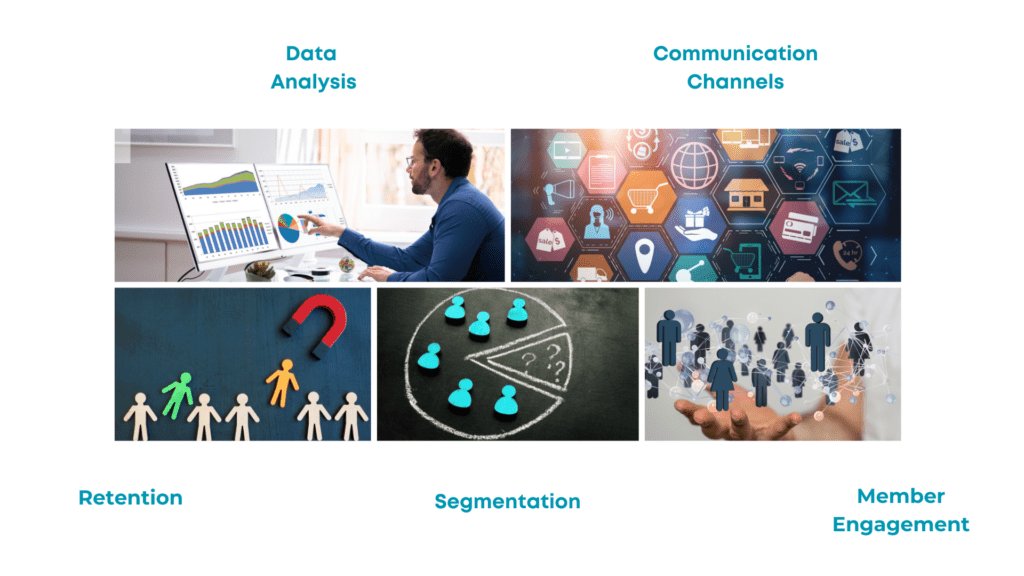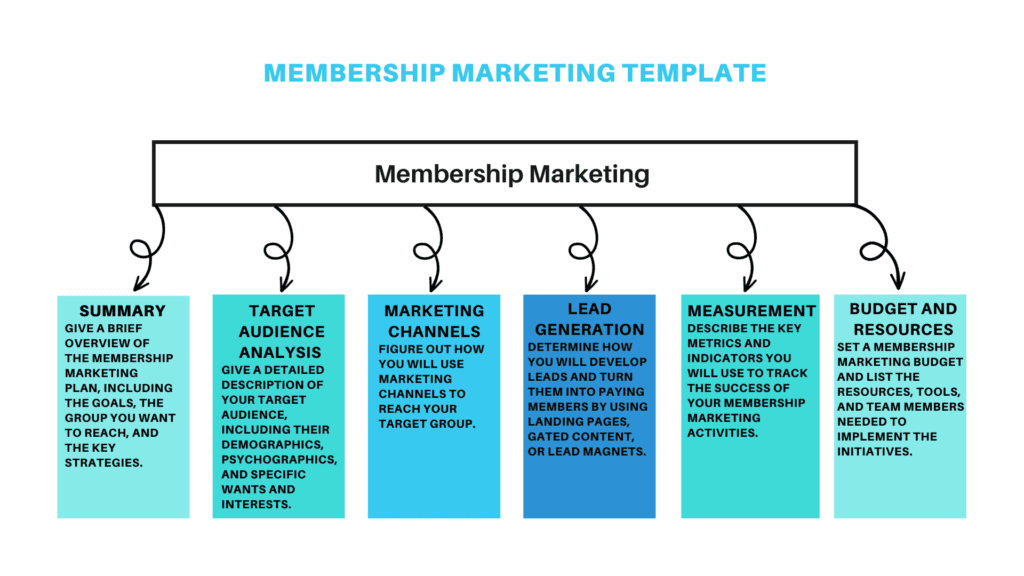Last Updated: October 3, 2023
Have you ever thought about what makes some membership-based organizations more successful than others?
Effective marketing strategy can be the key to an organization’s success in a world where customer tastes change quickly and technology changes the way we connect.
This is where MEMBERSHIP MARKETING comes into play.
The term “membership marketing” isn’t just a fad; it’s a powerful strategy that helps groups that are based on members stay alive and grow.
It’s very important for businesses and nonprofits that depend on subscriptions to be able to find, connect, and keep users.
Effective Marketing Strategies for Membership-Based Organizations

Effective marketing strategies tailored to their specific needs aren’t just a luxury for these organizations; they are a necessity for long-term success.
We’re going to go into great detail about the idea of a membership marketing campaign and explain why it’s so important for groups that depend on memberships.
Also, we’ll talk about how tailored marketing strategies can help them meet their goals, make sure they’ll be around for a long time, and build a strong group of members.
📚 Why You Should Read This? 📚
Curious about what membership marketing is? We’ll decode their secrets, explaining how and why they’re used, so you can make the most of them.
We are ready to expose you to everything you wonder about in membership marketing, please keep scrolling!
🔑 Key Points We’ll Explore:
- What is Membership Marketing?
- What is a membership strategy?
- Understanding Membership Marketing
- Why Membership Marketing is Important
- Building a Strong Membership Marketing Strategy
- The Benefits of a Solid Membership Marketing Plan
- Creating Compelling Membership Offers
- 8 Most Common Membership Marketing Channels
- 5 Ideas for Membership Marketing to Existing Customers
- 8 Steps for New Member Marketing
- Membership Marketing Tools and Resources
- Bonus: Free Membership Marketing Template
What is Membership Marketing?
Organizations, usually ones with a membership-based system, use membership marketing as a strategy to get prospective members, keep old ones, and give them value.
It includes a set of marketing activities and strategies that are made to meet the wants and interests of the members of the company.
Key elements of membership marketing include:

➡️ Member Acquisition: This is the process of getting new people or companies to become members of the group.
It usually includes advertising, promotional programs, and attempts to get in touch with people who might become users.
➡️ Member Engagement: Once someone joins a group, the goal is to keep them involved and active in it.
Communication, events, and projects that meet their wants and hobbies may be part of this.
➡️ Retention: It’s important for the long-term health of membership-based organizations that existing members are happy and repeat their memberships.
The goal of membership marketing tactics is to keep members from leaving and get them to repeat their memberships.
➡️ Value Proposition: Showing the worth and perks of being a member is at the heart of effective membership marketing.
This could mean getting access to special material, chances to meet new people, savings, or other perks.
➡️ Segmentation: Understanding that not all members have the same needs and interests, organizations often segment their membership base to provide more personalized marketing efforts.
➡️ Data Analysis: Membership marketing uses data analysis to learn more about how members behave, what they like, and how engaged they are.
This method, which is based on data, helps businesses improve their plans over time.
➡️ Communication Channels: Email, social media, websites, and direct mail are just a few of the ways that in the organization’s membership site talk to their members and share important information.
What is a Membership Strategy?
A membership strategy is an organization’s wide-ranging plan or framework for getting new members, keeping old ones, and helping them.
It’s a long-term plan that helps the group reach its participation growth, customer happiness, and long-term success goals.
Key components of a membership strategy typically include:
- Membership Goals and Objectives 🎯
- Clearly defined goals: Establish specific, measurable, achievable, relevant, and time-bound (SMART) objectives related to membership growth and engagement.
- Examples of goals: Increase membership by 15% in the next fiscal year, improve member retention rates by 10%, or generate a certain amount of revenue from memberships.
- Target Audience 👥
- Demographics: Identify the age, gender, location, profession, and other relevant demographic information of your ideal members.
- Needs and Interests: Understand the needs, interests, and pain points of your target audience. What problems can your organization solve for them?
- Segmentation: Group members based on shared characteristics to tailor marketing and engagement efforts effectively.
- Value Proposition 😍
- Unique Benefits: Clearly communicate the specific benefits and advantages of being a member of your organization. What makes your membership valuable?
- Personalization: Tailor your value proposition to different segments of your membership base, highlighting benefits that resonate with each group.
- Acquisition Strategies 💱
- Marketing Channels: Determine the most effective marketing channels (e.g., social media, email marketing, events, and referrals) for reaching potential members with your own membership site.
- Outreach Tactics: Develop strategies and tactics for attracting prospective members, such as targeted advertising campaigns or partnership opportunities.
- Retention Strategies 🔁
- Member Experience: Enhance the overall member experience by continually assessing and improving services, content, and engagement opportunities.
- Communication: Establish consistent and personalized communication plans to keep members engaged, informed, and connected with the organization.
- Renewal Incentives: Develop strategies to encourage members to renew their memberships, such as early renewal discounts or exclusive benefits for long-term members.
Understanding Membership Marketing
Membership marketing is a specific method used by groups with a member-based structure. Its goal is to build long relationships, provide ongoing value, and foster a sense of community among members.
It is not the same as standard marketing, which tries to get more customers and do deals that last less time.
Membership Marketing Definition and Significance

Member-based groups are the main ones that use membership marketing, which is a specific type of marketing.
It’s all about getting new users, keeping old ones, keeping them interested, and giving them worth.
Membership marketing is important because it helps build strong, long-lasting ties with members, keeping them happy and loyal while also bringing in steady money for the group.
Here are some important points that show how important it is:
- Sustained Support: Groups that depend on membership depend on the ongoing support of their members, which can come in the form of dues, donations, or participation. This ongoing support is guaranteed by membership promotion that works.
- Community Building: It makes people feel like they are part of a group by giving them a common identity and purpose. This can lead to more participation and advocacy.
- Steady Revenue Stream: Fees and membership dues often provide a steady and regular source of income, which helps groups better plan and budget.
- Long-Term Relationships: Membership marketing focuses on keeping members, which builds connections that last a long time. These connections can go beyond business deals, turning members into loyal allies.
Differences from Traditional Marketing

There are a few ways that membership marketing is different from regular marketing:
- Focus on Existing Members: Traditional marketing focuses on getting new customers, but membership marketing focuses on keeping existing members and building ties with them to keep them loyal.
- Value-Centric: Giving members ongoing value is a big part of membership marketing to keep them interested and keep them as members. In traditional marketing, short-term sales and deals may be given more weight.
- Community Building: A common goal of membership marketing is to help members feel like they are part of a group, which leads to a stronger relationship. Most of the time, traditional marketing tries to reach as many people as possible without trying to build communities.
- Long-Term Perspective: Membership marketing looks at things in the long term, trying to keep ties with members going for a long time. When it comes to campaigns, traditional marketing can be quicker.
- Personalization: In membership marketing, members are often put into groups based on their likes, dislikes, habits, and needs. This lets contact and offers be very specific to each group. A broad, one-size-fits-all method may be used in traditional marketing.
- Revenue Model: Fees or dues that are paid on a regular basis are a common way for membership marketing to make money. In traditional marketing, sales may only happen once in a while or from time to time.
Why Membership Marketing Is Important?
Membership-based groups need membership campaigns more than anything else. It is a key part of getting prospective members, keeping existing members interested, and making them more active.
By using good membership marketing strategies, groups can make it easier to get new members, get them more involved, and reach their goals and objectives.
Here are the top two important things about membership marketing:
Growth and Sustainability

Membership marketing is important for groups to grow and stay in business. It helps bring in new members, so the number of members grows and more money comes in.
With a well-made membership marketing plan, organizations can explain the benefits of membership in a way that makes people want to join and get involved.
By always taking care of and involving their members, organizations can build trust and ensure their long-term success.
Member Engagement and Retention

Membership marketing is not only about getting new members but also about keeping the ones you already have interested and happy.
It lets organizations change how they talk to their members and what they offer based on their wants and interests.
By using creative membership marketing ideas like private events, personalized communication, and member benefits, groups can get their members more involved, build strong relationships, and keep them coming back.
Building a Strong Membership Marketing Strategy
Organizations that depend on member support need to have a strong membership marketing strategy in order to be successful and last.
Crafting Your Membership Marketing Strategy
Outlining a detailed plan that helps you draw, connect, and keep members is an important part of making a membership marketing strategy.
These are the most important parts of this step:
1️⃣ Make Your Membership Goals Clear: To start, make your membership program’s goals clear and specific.
2️⃣ Segment Your Membership Base: Based on similar traits, hobbies, or needs, divide your membership base into groups.
3️⃣ Allocate Resources and Budget: Figure out how much money and resources you’ll need to put your membership marketing plan into action.
4️⃣ Choose Marketing Channels: Figure out which marketing outlets will help you reach your target group the best.
5️⃣ Develop Content and Messaging: Make content and messaging that your target audience will connect with and that reinforces your value offer.
Identifying Your Target Audience

A key part of your membership marketing plan is figuring out who your target group is.
For successful outreach, you need to know who your possible members are and what drives them to join. How to do it:
- Demographics: Find out about your perfect members’ age, gender, area, job, amount of income, and other demographic information. This information gives your marketing efforts a solid base.
- Psychographics: Learn more about the mental health of the people you want to reach. Find out what they like, what they believe, what they value, and how they act when it comes to your organization’s goals or services.
- Needs and Pain Points: Write down the exact problems, needs, and pain points that your group can solve. Customize your message to stress how becoming a member can help solve these problems.
- Member Personas: Make detailed member characters that show how different groups of your target audience behave and what drives them. You can use these characters as guides for your marketing efforts.
The Benefits of a Solid Membership Marketing Plan
Having a good membership marketing plan is helpful for organizations that want to attract, engage, and keep members.
A well-thought-out and strategic plan shows how to run successful membership marketing programs and projects.
Here are some of the most important reasons why you need a good membership marketing plan:
Clear Objectives and Direction
A membership marketing plan can help you set clear goals and give your marketing efforts direction.
It spells out specific goals, descriptions of the people you want to reach, messages to send, and strategies to use.
By having a well-thought-out plan, businesses can make sure that their marketing activities are in line with their general business goals, which makes for a focused and unified approach.
Efficient Resource Allocation
A membership marketing plan helps groups use their resources well.
It helps figure out how much money, people, and tools are needed to put the marketing tactics in the plan into action.
With a clear picture of what resources are needed, companies can maximize their investments and make sure that their resources are being used in the most effective way.
Consistency and Coherence
A membership marketing plan helps make sure that all of your marketing efforts are consistent and make sense.
It makes sure that your content, branding, and contact channels are the same across all of your projects and campaigns.
This consistency helps your target audience get to know and trust your brand, which boosts the importance of membership and improves the image of your organization.
Creating Compelling Membership Offers
A key part of membership marketing is making membership deals that people want to take up.
It involves making membership deals that look good so that potential members want to join and current members want to repeat their memberships.
These are the most important steps in the process:
Crafting Irresistible Membership Offers

Define Membership Tiers: Make different classes or tiers of membership, and give each one its own set of perks and features.
You could, for instance, have a basic level with basic benefits and a luxury level with extra benefits.
Exclusive Benefits: Give members benefits that no one else can get. Some of these are discounts, access to premium material, events that are only open to users, and personalized help.
Limited-Time Offers: Sometimes give new members discounts or special deals that are only available for a short time to make them feel like they need to act quickly. This might make possible members more likely to act right away.
Trial Memberships: If you don’t want to commit to a full membership right away, you could offer trial memberships or a money-back promise to help people decide.
Pricing Strategies for Membership Models

By making appealing membership deals and using smart pricing strategies, you can effectively draw and keep members, which is important for the success and long-term survival of your membership-based organization.
Value-Based Pricing: Make sure that your prices are in line with how valuable people think your memberships are. Think about how much your target audience is willing to pay for the perks and special access that your group offers.
Tiered Pricing: Divide your memberships into different levels with different prices and benefits. This makes it possible for more people with different wants and funds to become members.
Freemium Model: To get more people to join, you might want to give a free or cheap introductory level of participation. Then, sell these people higher-level plans with more options.
Discounts and Promotions: Use discounts, deals, and other benefits to get new members or get current members to repeat. Offers with a time limit, early bird savings, or prizes for referring friends are some examples.
Monthly vs. Annual Payments: Give people a choice of how to pay by letting them choose between monthly and yearly fees. A discount is often given for annual payments to encourage people to make longer agreements.
8 Most Common Membership Marketing Channels

With a comprehensive approach that combines these channels, organizations can create successful membership marketing campaigns that foster growth and engagement.
Here are the eight common membership marketing channels:
- Website
The brand’s website is where members can go to learn more about the program, join, and manage their membership accounts. It can also be used to promote limited-access content, exclusive deals, and one-of-a-kind suggestions.
- Email Marketing
When it comes to reaching out to participants, email is king. Newsletters, special promotions, invites to events, and information on new offerings can all be sent straight to members’ inboxes from brands.
- Mobile Apps
Members may easily access their accounts, benefits, and special features with the help of specialized mobile applications. Push notifications allow mobile apps to provide members with relevant and timely communications.
- Social Media
One of the most important marketing channel is social media. Engaging with members, providing them with access to special content, and hosting contests and promotions are all possible through social media. By encouraging members to engage with one another and the brand, social media can help cultivate a strong sense of community.
- Content Marketing
Membership marketing relies heavily on content marketing strategies, which involve the production and distribution of high-quality content, including blog posts, articles, and videos.
- Direct Mail
Membership offers, membership cards, and special offers can all be sent directly to members’ mailboxes via traditional direct mail. If you’re looking to reach a specific subset of your membership or provide physical gifts, this channel may be the way to go.
- Live Events or Webinars
Members can gain insight, education, and networking opportunities at these events, which might take the form of workshops, lectures, product demos, or Q&A sessions.
- Customer Service
Membership benefits can be reaffirmed during contacts with customer service representatives. Members can receive individualized help, have their complaints addressed, and be made aware of additional resources and privileges available only through the service’s dedicated staff.
5 Ideas for Membership Marketing to Existing Customers
- VIP Experiences
As a way to thank your loyal customers, give them events that only they can have and that they will never forget.
This could include VIP admission to events, behind-the-scenes tours, meet-and-greets with industry experts or celebrities, or even personalized one-on-one consultations.
Giving your customers unique and memorable moments will make them feel more connected to your brand.

- Surprises Gifts and Delights
Impress your current customers with gifts or personal touches they didn’t expect along their membership journey.
This could mean giving them special edition products, limited-edition items, or curated gift boxes that are based on what they like and what they are interested in.
These unexpected acts of kindness will make your customers feel appreciated and create a sense of excitement and expectation.
- Opportunities for Co-creation
Get your current customers involved in the process of making new goods or services.
This can be done with exclusive beta testing programs, focus groups, or polls where customers can give input and feedback.
By getting them involved in the development process, you not only make them feel like you care about them, but you also give them a sense of ownership over your brand and make them more loyal to it.
- Customized Celebrations of Milestones
Celebrate important dates or achievements with your current customers in a personal way.
This could mean sending them personalized texts or videos from your team, giving them special discounts or rewards, or even setting up virtual or in-person events to celebrate their journey with your brand.
Customers will feel closer to you if you acknowledge and celebrate the important moments in their lives.
- Exclusive Access to Insights about the Industry
Give your current customers access to valuable business insights, content from thought leaders, or educational tools.
This could be done through webinars, or conversations with experts in the field.
By making your membership program a source of useful information and tips, you not only improve their experience but also make your brand a known authority in your field.

8 Steps for New Member Marketing
With the right membership marketing ideas, membership marketing strategies, and membership marketing plan template, as well as the help of a membership marketing agency if you need it, you can get significant results in growing your membership program.
Step 1: Identify Target Audience
Find out what kind of person or group of people you want to reach with your membership program. Find out what they want, what they’re interested in, and what hurts them, so you can make your marketing messages more effective.
Step 2: Define Value Proposition
Make it clear what makes your membership program special and what its perks are. Show how it solves problems, gives you access to special tools, or connects you to a helpful community.
Step 3: Create Incentive Messages
Make marketing messages that are convincing and interesting, and tell potential members what the value offer is. Pay attention to how becoming a member will improve their lives, careers, or businesses.

Step 4: Choose Your Marketing Channels
Choose the best marketing platforms to reach the people you want to reach. This could be done through email marketing, social media, content marketing, online ads, partnerships, or events on your membership site.
Step 5: Create Engaging Content
Create high-quality material that speaks to the people you want to reach. This can be done with blog posts, articles, videos, webinars, or downloadable tools that meet their needs and show off the benefits of membership.
Step 6: Use Generating Leads Strategies
Use lead generation strategies like landing pages, gated content, and lead magnets to get possible members’ contact information. Offer something of value in return, like a free e-book or access to material that isn’t available anywhere else.

Step 7: Initiative and Follow-Up
Get to know possible members by setting up a good process for nurturing leads. Send prospects targeted emails with personalized content, and keep in touch with them to answer any questions or worries they may have.
Step 8: Track and Optimize
Keep track of how well your efforts to recruit new members are working. Keep an eye on important measures like conversion rates, levels of engagement, and the costs of getting new members. Use this information to change your strategies and improve your marketing efforts.
Membership Marketing Tools and Resources

1-Customer Relationship Management Software
This type of software helps you keep track of interactions with members, handle their information, and divide your membership base into groups that you can then sell to more specifically.
For example, Salesforce, HubSpot CRM, and Zoho CRM are all popular CRM choices.
2-Email Marketing Platforms
Email marketing is a great way to stay in touch with members.
You can use tools like Mailchimp, Constant Contact, or SendinBlue to make and send automated email campaigns that will keep users interested and spread the word about events or content.
3-Social Media Management Tools
Hootsuite, Buffer, and Sprout Social are some tools that can help you plan and manage your social media posts, keep an eye on activity, and look at your success across multiple social media marketing platforms.
4-Content Management System
You need a CMS like WordPress or Drupal to keep your website up to date. This is where you can put useful content like event plans and tools that are only available to members.
5-Event Management Software
If you put on events for your users, you might want to use an event management app like Eventbrite or Cvent to plan, advertise, and keep track of who has signed up.
6-Membership Software
Software like Wild Apricot, MemberClicks, or MemberPress makes it easier for people to become members, update their memberships, and get their benefits.
Free Membership Marketing Template
Here is our free membership marketing template!
This template was made to help businesses set up a complete marketing plan that fits their specific needs. It gives you an organized framework to guide your membership marketing efforts.
By using this form, you can speed up the process of planning your marketing and make sure you have a cohesive plan that makes the most of your membership program.
Simply click on the link to access the free template.

Final Words on Membership Marketing
It’s time to part.
We’re just kidding 😂, but we are happy to say that you have come to the end of this post.
We hope you found every detail you were looking for.
Let’s see what we talked about briefly, shall we? ✨
Membership marketing is an indispensable strategy for organizations that rely on memberships.
It paves the way for growth, community development, and sustained success.
Crafting enticing offers, implementing effective pricing strategies, and leveraging diverse marketing channels is key to thriving in the competitive world of membership-based associations and businesses.
In a rapidly evolving landscape, membership marketing is the cornerstone of establishing lasting connections with members.
By adopting these strategies, organizations can secure their future, foster engagement, and ensure the enduring value of their membership programs.
FAQs about Membership Marketing
1-What is Membership Marketing?
Membership marketing is a way for businesses to get new members, keep the ones they have, and grow their communities by giving members personalized value and making the community stronger.
2-How is Membership Marketing different from traditional marketing?
In contrast to standard marketing, which focuses on getting new customers and making quick sales, membership marketing focuses on keeping members and building communities.
3-Why is Membership Marketing important?
Membership marketing is very important for groups that depend on membership to keep getting support, build loyalty, and make sure they have a steady amount of income.
4-What are key components of a Membership Strategy?
A membership strategy includes clear goals, a list of existing members, value propositions, methods for getting new members and keeping old ones, and different pricing choices.
5-What tools and resources are essential for Membership Marketing?
CRM software, email platforms, social media platform, content management systems (CMS), event management software, and membership software are all important tools for membership marketing because they help with contact and involvement.






